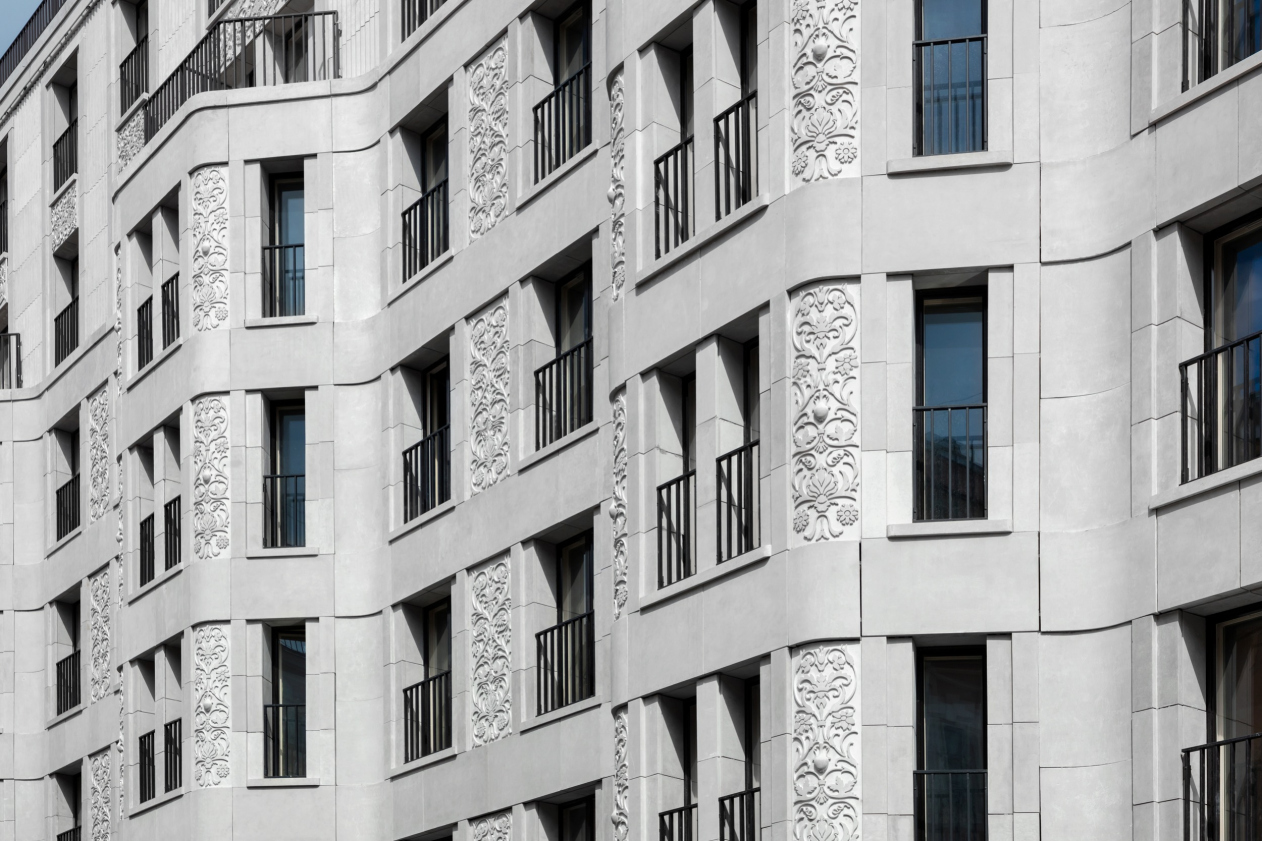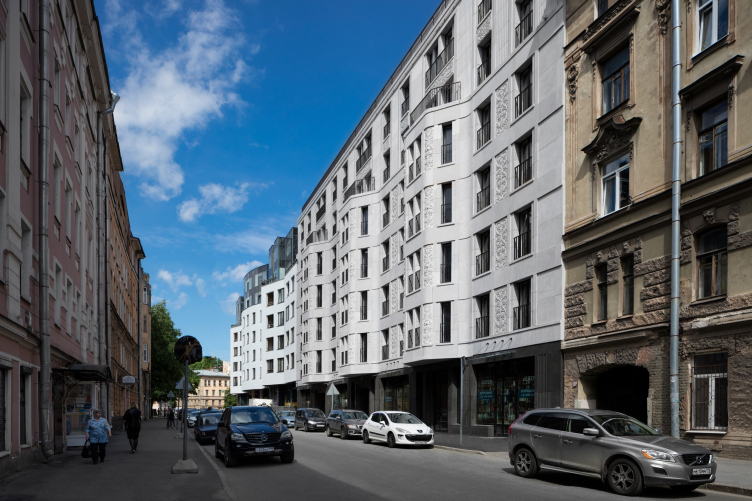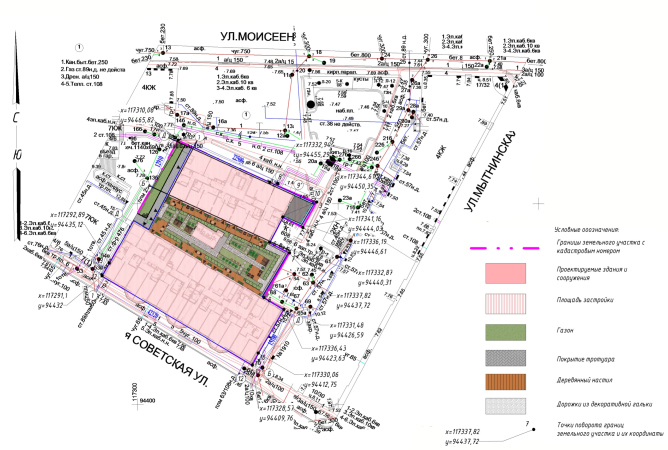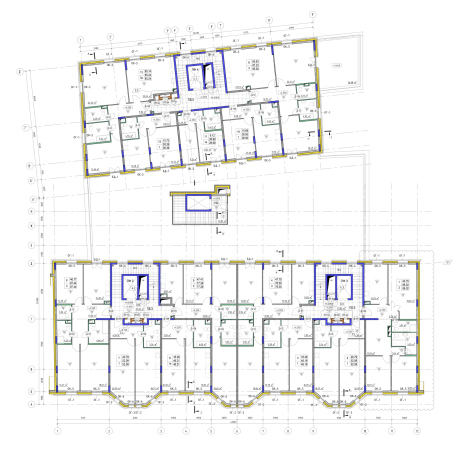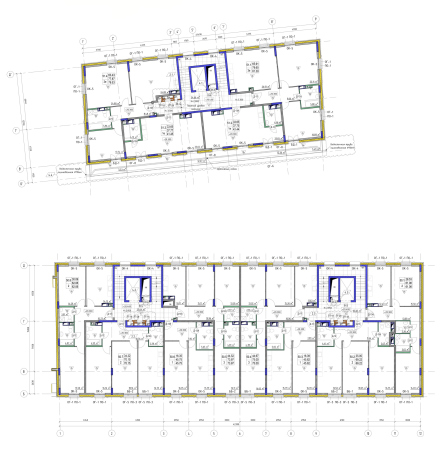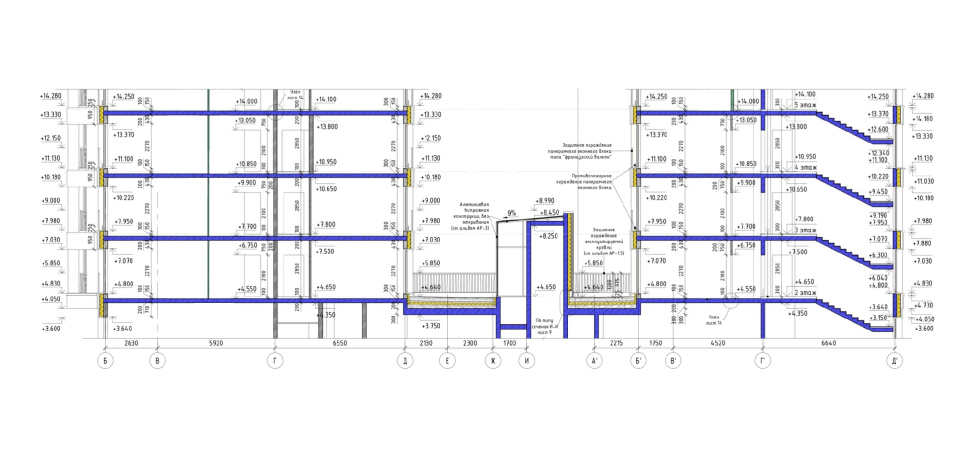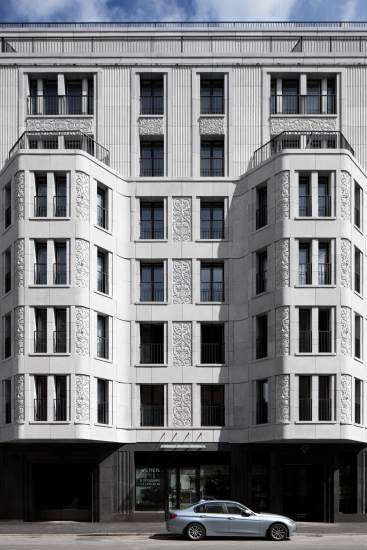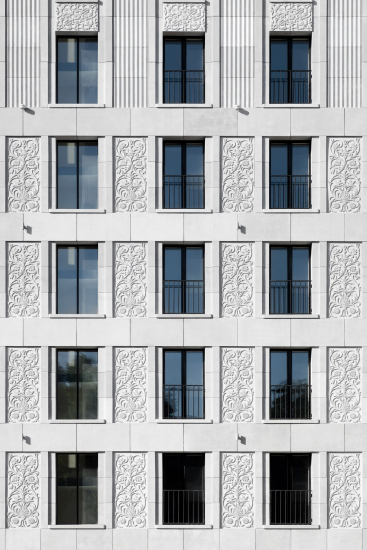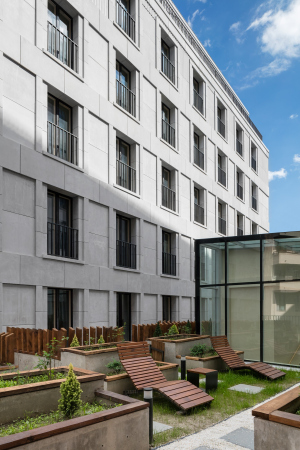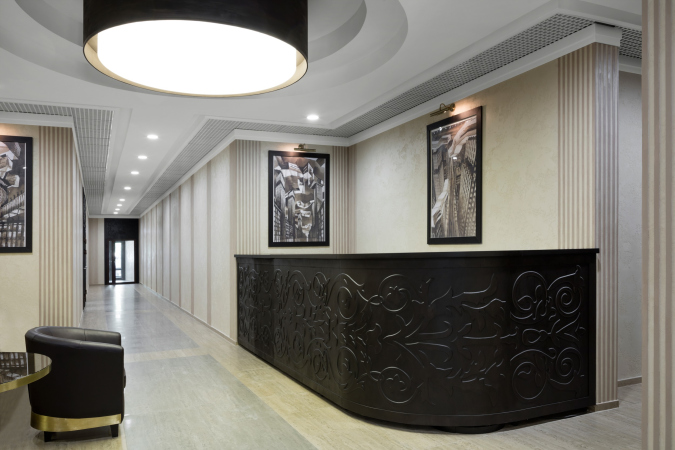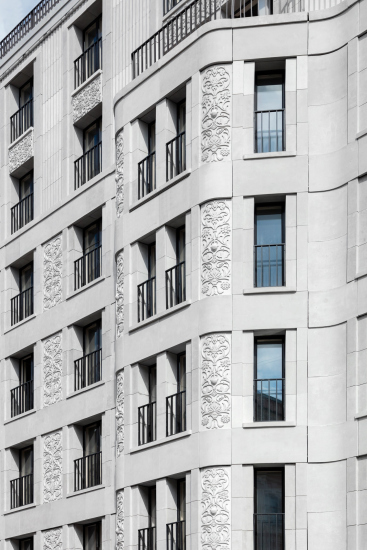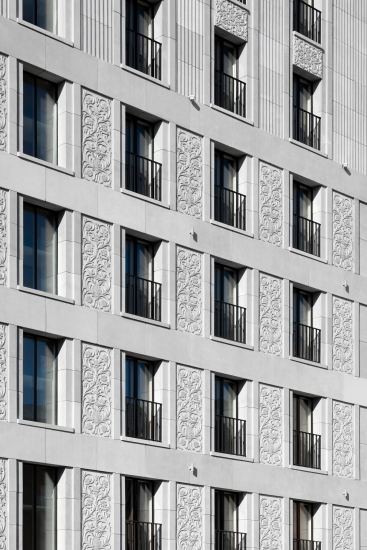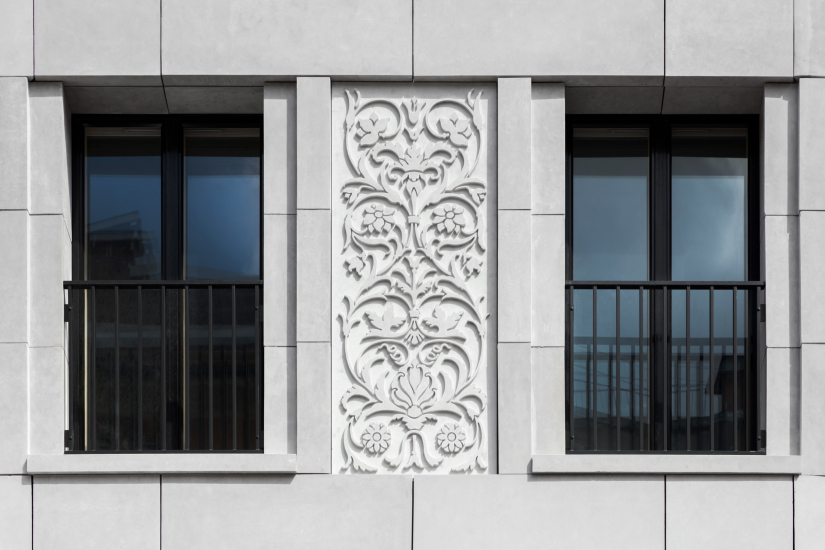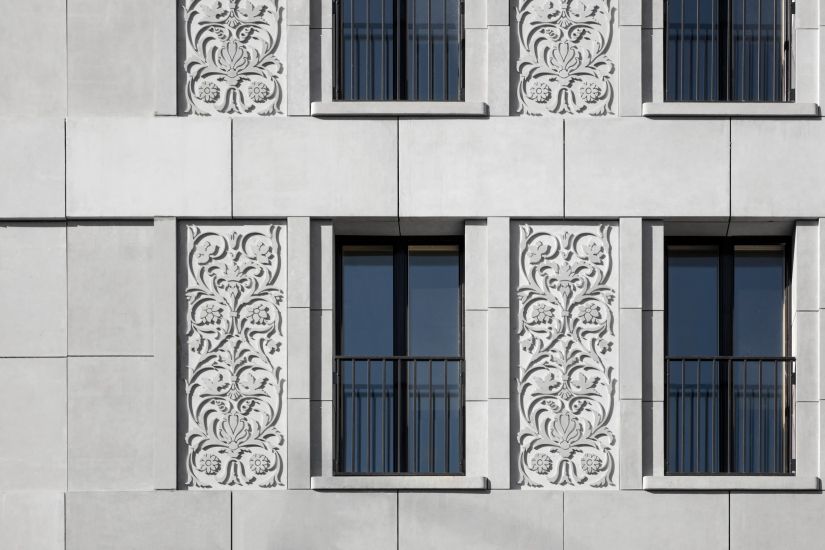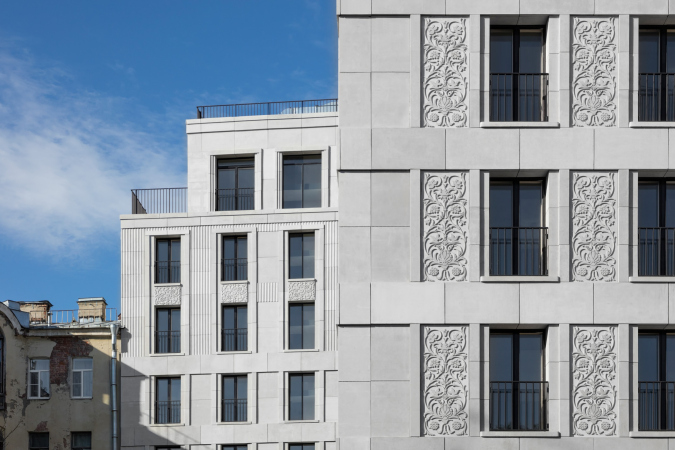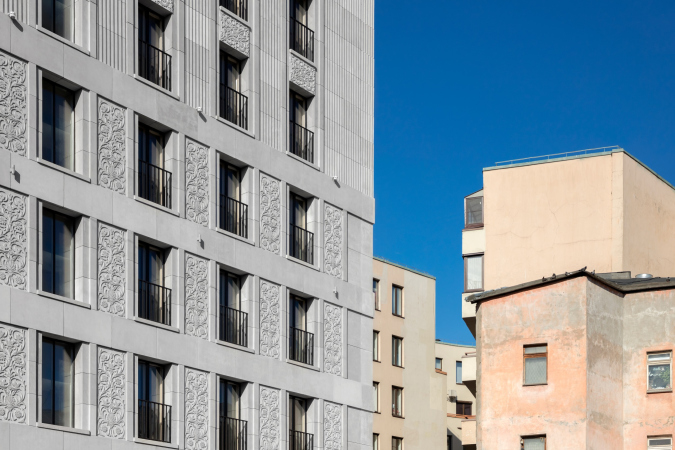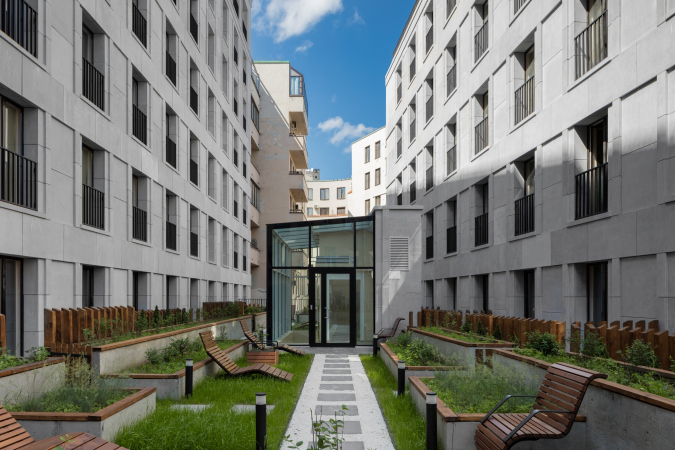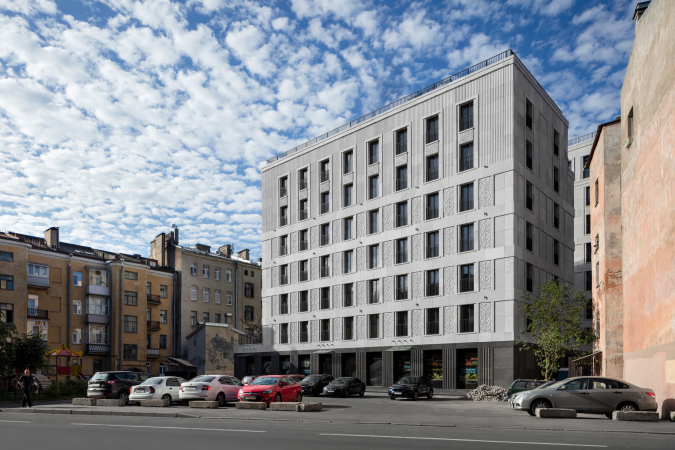Veren Place housing complex
Copyright: Photograph © Dmitry Chebanenko
Let’s, however, start off by making a small digression dedicated to the “30:70” strategy (the book “30:70. Architecture as a Balance of Forces” was out in 2017; Sergey Tchoban repeatedly presented it at his lectures both in Russia and abroad). One of the most important messages that it carries is that a harmonious city cannot consist of iconic buildings alone – they must constitute no more than 30% of it, the other buildings playing a background part, yet with thoroughly detailed facades. These need not, or rather, must not be of neoclassical architecture; instead, these should be different variations of Art Deco, but other options are also possible.
On the 10th Sovetskaya Street, which is not excessively long, there are two houses standing at the beginning and at the end. One of them, the corner one, iconic and modernist, was designed by Studio 44, headed by Nikita Yavein. According to Sergey Tchoban, this building is a typical corner dominant with an unusual floor plan and active forms. On the other corner of the 10th Sovetskaya, where it meets the Mytninskaya Street, stands the former Ivan Smirnov tenement (1902, designed by Andreev and Pavlov). Both houses occupy about a third of the street each. The land site between them was allotted for the construction of Veren Place. The complex is designed in the spirit of Art Deco, although with some clearly modern features, which means that the Veren Place building has joined the background construction of St. Petersburg, and the ratio of the houses on the street neared the 30:70 strategy. All the houses on the opposite side of the streets are tenements of the early XX century, moderately decorated and rather ordinary for their time, intercepted by a park at one point.
The housing complex Veren Place consists in fact of two buildings standing on a common stylobate: one unit stretches along the street, and the other stands almost parallel to it inside the block; between them, there is a private residents-only green yard on the roof of the parking garage. From the yard side, one gets through the glass grand entrance both into the hallway (whose design matches the overall artistic concept of the complex), and to the underground parking garage. In the cramped space of the historical city, the parking system features not a habitual ramp, but a special parking elevator. The house has 80 apartments and 45 parking places in it – this ratio is great for the environment. The apartment floor space ranges from 40 to 105 square meters.
The outer building features a highly developed plastique with bay windows, characteristic of St. Petersburg houses. The inner building, which overlooks a mini park is without bay windows, yet with the same pattern structure.
The traditional three-part vertical composition of the facades – bottom, middle and top (a basement floor, four mezzanine floors and two upper floors plus an attic) – is observed in both buildings. And, of course, another thing that they have in common is the ornaments on the piers. Here the architects used a musical principle: the overall form is subdivided into themes that sound and repeat, developing and changing slightly each time. Both grand facades are filled with details, while the yard facades are more reserved.
The main facade on the street side is organized by a large rhythm of three bay windows. The main thing, however, as was already said, is what this large form consists of, the themes and details. First of all, Veren Place politely bows to its neighbors. It is just as black and white as the house designed by Nikita Yavein (white top, black bottom), and it continues the wavy character of its neighbor in its trapeze-shaped bay windows, at the same time “calming it down” and bringing it to order. And the next tenement in line features bay windows on the corner that are even more austere and rectangular. The motif of two narrow windows that split the bay windows of Veren Place echoes the neighboring tenement as well. Such windows are characteristic for the Art Nouveau times; when they resurfaced in modern architecture, they took on a more austere shape. The other windows have a two-squares-side-by-side proportion, just like the windows of many other historical buildings in Saint Petersburg, the pleasant difference being that these are French windows reaching to the floor.
Veren Place housing complex
Copyright: Photograph © Dmitry Chebanenko
The traces of classical order architecture, even if visible at all, are latently present: Sergey Tchoban believes that the classics is akin to the Latin language – however beautiful it is, limiting yourself to classics alone is like cooking meals from just one ingredient. In the black “granite” (actually, fiber-concrete) plinth, only a hint of pilasters in grooved blades is left. The windows are separated by smooth horizontal bands, and in this particular context it does not make much difference whether the window rests on the band or the other way around, the band serving as the top framing for the window.
Veren Place housing complex
Copyright: Photograph © Dmitry Chebanenko
The design solution of the facade layers is indeed remarkable. On the one hand, the wall definitely has its plastique, layers, depth, and play of light and shade – all the qualities that a city house must possess to win people’s trust. On the other hand, it is not just an interpretation of the traditional wall. The layers are intertwined in a rather sophisticated way, making one want to examine them and take in the details. There is also a parallel with high fashion that occurred to me (with which Sergey Tchoban agreed), when it’s all only seemingly simple, but after you take a closer look, you find a lot of designer thought in there. For example, a simple black jacket features an unconventional construction – the lapel of the jacket goes into the pocket, as in a möbius strip: it was just an additional surface and suddenly became the main one. Accordingly, the facade of Veren Place has the wall level, and a level of frames superimposed on it: wide horizontal ribbons between the floors play the role of upper frames for windows (instead of a window casing), and vertical narrow rods become side frames (instead of pilasters). At the same time, these ribbons and molds are part of one surface, which divides the facade into cells. Some of the cells, spaced at regular intervals, have ornaments in them. The main surface of the wall, along with the molds, also flanks the windows. The outside window sills form yet another layer, which prominently stands out, accentuating the role of the windows upon the facade. As a result, one’s eye is always unraveling the riddle – where is the main surface, where is the secondary one, where is the protrusion, where is the depression, where is the background, and where is the frame. And this is just what Sergey Tchoban declares in his book: the human gaze must have something to hold on to. On the whole, what it ends up being is a shape that is harmonious and convincing. (Please read more about the efficiency of vertical windows in St. Petersburg in the interview).
The signature element of the building is the ornamental panel with florals, leaves, stars, and fruit (it is always worthwhile reminding the resident of a megalopolis about the Garden of Eden). A few types of repeating patterns in the piers look like “stone” carving, but in fact these are slabs of high-quality fiber-reinforced concrete about 5 cm thick, the depth of the ornament being 3 cm. In the comments and on social media people are discussing whether it is stone or not, which testifies to the creative success. The surface of the street part inherits the looks of the house at Granatny Lane, 8, which Sergey Tchoban designed back in 2008. In that house, the carved pattern covered the horizontals and verticals; the St. Petersburg house has more smooth surfaces, but the overall principle of ornaments, ribbons, and several layers, still holds.
I deliberately wrote about the semantics of the ornament, which is read by anyone, be that a kid or an old person, a man or a woman, a knowledgeable person or a layman, in a similar way. I have always been amazed at the sheer nerve of Adolf Loos, who more than a century ago denounced any ornament as an architectural atrocity and a sign of a savage, who is afraid of clean surfaces, despite the fact that magical protection is just one of the multiple meanings of the ornament, and not the most important nowadays, either. It is clear that there are other meanings – the connection to organic nature, flora and fauna symbols, the mathematical ratios within the rapport between the repeating patterns, and whatever else ornament may mean. Ornare means “to decorate” in Latin. Philosopher Hans Gadamer believes that the human need for decoration to be the source, and in some sense, the synonym of the beautiful. And in Greek, κοσμάτος (decorated) and κόσμος (order) are words that have the same root.
And it’s just great that Sergey Tchoban consistently implements his strategy. He proposes not just case-specific solutions but a whole new path that can be followed by many. Since the time “30:70” was written, his company completed such large-scale projects as Admiralteiskaya Sloboda in Kazan and a renovation bloc in Moscow’s Kuzminki. The recently completed architectural ensemble VTB Arena Park successfully combines Art Deco houses by Sergey Tchoban and modernist houses by Vladimir Plotkin, this being the perfect case of a common denominator for both styles: modernism with a tint of classics and Art Deco with a tint of modernism are brought together through the rhythm. According to Sergey Tchoban, it is the rhythm, and not the classical order details that produce this magical effect on the observer – and the observer ultimately is every person of this city, and not just the resident of this house. The duality of freedom of expression and order, felt in the colonnades, in the repeating ornaments, and in musical constructs, yields the desired magic of rhythm that heals the spirit and the eye. These qualities are a basis of the human perception of the city. But then again, it is the architecture of Sergey Tchoban that consistently revives the ornament, inscribing it into the logic of the modern facades: besides the “Byzantine House”, one can recall Wine House, the corner building at the crossroads of the Leningrad Highway and the Third Transport Ring, and the signature housing project “Tsarskaya Ploshchad”, where the blade pattern also borrows the motifs of the carving of the Teremny Palace of the Moscow Kremlin.
In other words, ornamental facades by Sergey Tchoban can be already lined up in a whole new string, an individual narrative that the author has been developing for more than a decade as one of the directions of his work in search of new modern architecture, which would fit both a historical city and its resident.
Veren Place is yet another step in this direction. It picks up the rhythm of the city that surrounds it, and embodies, on the one hand, traditionally, by maintaining the height and the rows, the sequence of bay windows and the classical logic of vertical arrangement. On the other hand, one must note that the house is very contemporary – to feel that, it is enough to take a look at the tenements across the street. In such opposition, the house does not even look as though it belongs with the “seventy percent” of the rank-and-file construction: in addition to respect for the context, modern construction in a historical center requires a rather high quality of execution and materials, as well as clear and crisp outlines. And this house – bright, based on the contrast between almost-white and black, dissected with partitions and ribbed “flutes”, yet at the same time “wrapped” in bay windows like in an ocean wave – does not in the least look like a replica of its neighbors, but rather presents a sum of modern technologies and the author’s beliefs about the conceptual and emotional value of the ornament. It is this specific role – that of a building that balances on the verge of modernist and historical St. Petersburg, and dictated, probably, not only by the proximity of a relatively new and a relatively old building – that this house plays best of all.

